How to Draw Morphology Tree for Word Reformer
Morphology is the study of words and their parts. Morphemes, like prefixes, suffixes and base words, are defined as the smallest meaningful units of meaning. Morphemes are important for phonics in both reading and spelling, as well as in vocabulary and comprehension.
Why use morphology
Teaching morphemes unlocks the structures and meanings within words. It is very useful to have a strong awareness of prefixes, suffixes and base words. These are often spelt the same across different words, even when the sound changes, and often have a consistent purpose and/or meaning.

Types of morphemes
Free vs. bound
Morphemes can be either single words (free morphemes) or parts of words (bound morphemes).
A free morpheme can stand alone as its own word
- gentle
- father
- licence
- picture
- gem
A bound morpheme only occurs as part of a word
- -s as in cat+s
- -ed as in crumb+ed
- un- as in un+happy
- mis- as in mis-fortune
- -er as in teach+er
In the example above: un+system+atic+al+ly, there is a root word (system) and bound morphemes that attach to the root (un-, -atic, -al, -ly)
system = root un-, -atic, -al, -ly = bound morphemes
If two free morphemes are joined together they create a compound word. These words are a great way to introduce morphology (the study of word parts) into the classroom.
For more details, see: Compound words
Inflectional vs. derivational
Morphemes can also be divided into inflectional or derivational morphemes.
Inflectional morphemes change what a word does in terms of grammar, but does not create a new word.
For example, the word <skip> has many forms: skip (base form), skipping (present progressive), skipped (past tense).
The inflectional morphemes -ing and -ed are added to the base word skip, to indicate the tense of the word.
If a word has an inflectional morpheme, it is still the same word, with a few suffixes added. So if you looked up <skip> in the dictionary, then only the base word <skip> would get its own entry into the dictionary. Skipping and skipped are listed under skip, as they are inflections of the base word. Skipping and skipped do not get their own dictionary entry.
Skip
verb, skipped, skipping.
- to move in a light, springy manner by bounding forward with alternate hops on each foot. to pass from one point, thing, subject, etc.,
- to another, disregarding or omitting what intervenes: He skipped through the book quickly.
- to go away hastily and secretly; flee without notice.
From Dictionary.com - skip
Another example is <run>: run (base form), running (present progressive), ran (past tense). In this example the past tense marker changes the vowel of the word: run (rhymes with fun), to ran (rhymes with can). However, the inflectional morphemes -ing and past tense morpheme are added to the base word <run>, and are listed in the same dictionary entry.
Run
verb, ran, run, running.
- to go quickly by moving the legs more rapidly than at a walk and in such a manner that for an instant in each step all or both feet are off the ground.
- to move with haste; act quickly: Run upstairs and get the iodine.
- to depart quickly; take to flight; flee or escape: to run from danger.
From Dictionary.com - run
Derivational morphemes are different to inflectional morphemes, as they do derive/create a new word, which gets its own entry in the dictionary. Derivational morphemes help us to create new words out of base words.
For example, we can create new words from <act> by adding derivational prefixes (e.g. re- en-) and suffixes (e.g. -or).
Thus out of <act> we can get re+act = react en+act = enact act+or = actor.
Whenever a derivational morpheme is added, a new word (and dictionary entry) is derived/created.
For the <act> example, the following dictionary entries can be found:
Act
noun
- anything done, being done, or to be done; deed; performance: a heroic act.
- the process of doing: caught in the act.
- a formal decision, law, or the like, by a legislature, ruler, court, or other authority; decree or edict; statute; judgement, resolve, or award: an act of Parliament.
From Dictionary.com - act
React
verb
- to act in response to an agent or influence: How did the audience react to the speech?
- to act reciprocally upon each other, as two things.
- to act in a reverse direction or manner, especially so as to return to a prior condition.
From Dictionary.com - react
Enact
verb
- to make into an act or statute: Parliament has enacted a new tax law.
- to represent on or as on the stage; act the part of: to enact Hamlet.
From Dictionary.com - enact
Actor
noun
- a person who acts in stage plays, motion pictures, television broadcasts, etc.
- a person who does something; participant.
From Dictionary.com - actor
Teachers should highlight and encourage students to analyse both Inflectional and Derivational morphemes when focussing on phonics, vocabulary, and comprehension.
For more information, see:
Prefixes, suffixes, and roots/bases
Many morphemes are very helpful for analysing unfamiliar words. Morphemes can be divided into prefixes, suffixes, and roots/bases.
- Prefixes are morphemes that attach to the front of a root/base word.
- Suffixes are morphemes that attach to the end of a root/base word, or to other suffixes (see example below)
- Roots/Base words are morphemes that form the base of a word, and usually carry its meaning.
- Generally, base words are free morphemes, that can stand by themselves (e.g. cycle as in bicycle/cyclist, and form as in transform/formation).
- Whereas root words are bound morphemes that cannot stand by themselves (e.g. -ject as in subject/reject, and -volve as in evolve/revolve).
Most morphemes can be divided into:
- Anglo-Saxon Morphemes (like re-, un-, and -ness);
- Latin Morphemes (like non-, ex-, -ion, and -ify); and
- Greek Morphemes (like micro, photo, graph).
It is useful to highlight how words can be broken down into morphemes (and which each of these mean) and how they can be built up again).
For example, the word <unreliability> may be unfamiliar to students when they first encounter it.
If <unreliability> is broken into its morphemes, students can deduce or infer the meaning.

So it is helpful for both reading and spelling to provide opportunities to analyse words, and become familiar with common morphemes, including their meaning and function.
Compound words
Compound words (or compounds) are created by joining free morphemes together. Remember that a free morpheme is a morpheme that can stand along as its own word (unlike bound morphemes - e.g. -ly, -ed, re-, pre-). Compounds are a fun and accessible way to introduce the idea that words can have multiple parts (morphemes). Teachers can highlight that these compound words are made up of two separate words joined together to make a new word. For example dog + house = doghouse
Examples
- lifetime
- basketball
- cannot
- fireworks
- inside
- upside
- footpath
- sunflower
- moonlight
- schoolhouse
- railroad
- skateboard
- meantime
- bypass
- sometimes
- airport
- butterflies
- grasshopper
- fireflies
- footprint
- something
- homemade
- backbone
- passport
- upstream
- spearmint
- earthquake
- backward
- football
- scapegoat
- eyeball
- afternoon
- sandstone
- meanwhile
- limestone
- keyboard
- seashore
- touchdown
- alongside
- subway
- toothpaste
- silversmith
- nearby
- raincheck
- blacksmith
- headquarters
- lukewarm
- underground
- horseback
- toothpick
- honeymoon
- bootstrap
- township
- dishwasher
- household
- weekend
- popcorn
- riverbank
- pickup
- bookcase
- babysitter
- saucepan
- bluefish
- hamburger
- honeydew
- thunderstorm
- spokesperson
- widespread
- hometown
- commonplace
- supermarket
Example activities of highlighting morphemes for phonics, vocabulary, and comprehension
There are numerous ways to highlight morphemes for the purpose of phonics, vocabulary and comprehension activities and lessons.
Highlighting the morphology of words is useful for explaining phonics patterns (graphemes) and spelling rules, as well as discovering the meanings of unfamiliar words, and demonstrating how words are linked together. Highlighting and analysing morphemes is also useful, therefore, for providing comprehension strategies.
Examples of how to embed morphological awareness into literacy activities can include:
- Sorting words by base/root words (word families), or by prefixes or suffixes
- Word Detective - Students break longer words down into their prefixes, suffixes, and base words
- e.g. Find the morphemes in multi-morphemic words like: dissatisfied unstoppable ridiculously hydrophobic metamorphosis oxygenate fortifications
- Word Builder - students are given base words and prefixes/suffixes and see how many words they can build, and what meaning they might have:
- Prefixes: un- de- pre- re- co- con-
Base Words: play help flex bend blue sad sat
Suffixes: -ful -ly -less -able/-ible -ing -ion -y -ish -ness -ment - Etymology investigation - students are given multi-morphemic words from texts they have been reading and are asked to research the origins (etymology) of the word. Teachers could use words like progressive, circumspect, revocation, and students could find out the morphemes within each word, their etymology, meanings, and use.
carbajaliggerstoost.blogspot.com
Source: https://www.education.vic.gov.au/school/teachers/teachingresources/discipline/english/literacy/readingviewing/Pages/litfocuswordmorph.aspx
0 Response to "How to Draw Morphology Tree for Word Reformer"
Postar um comentário